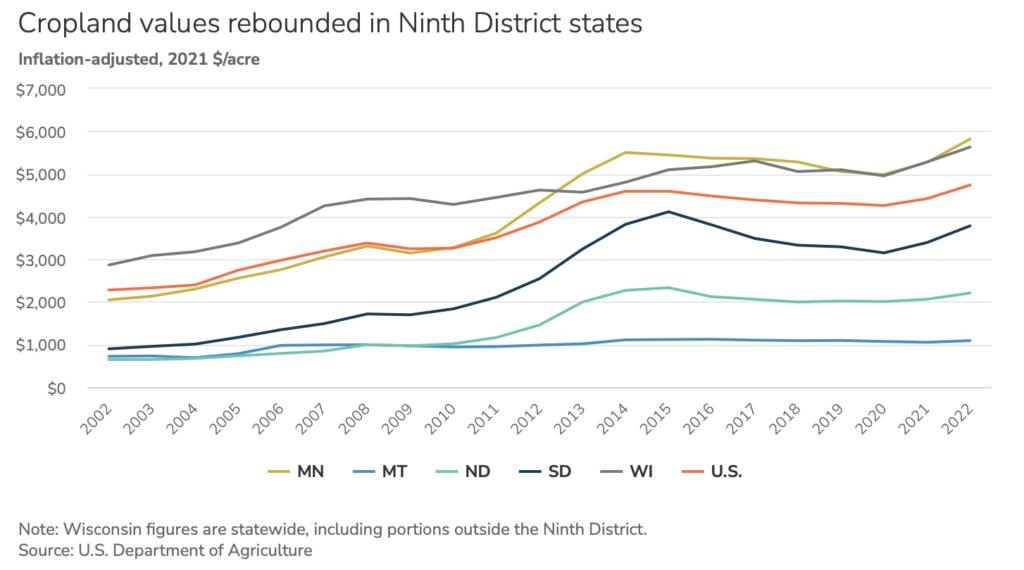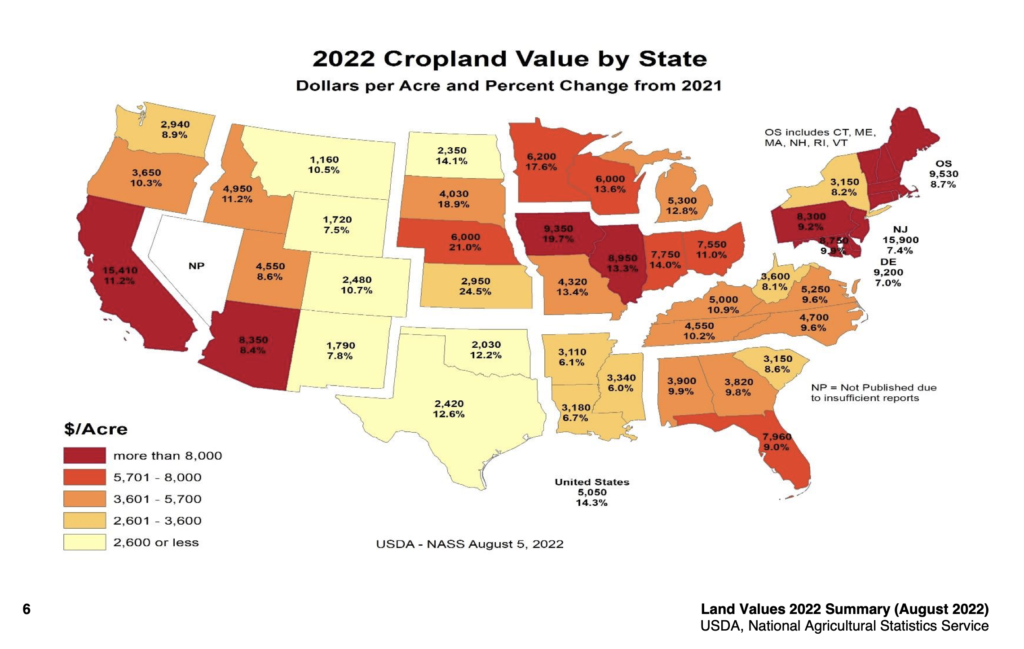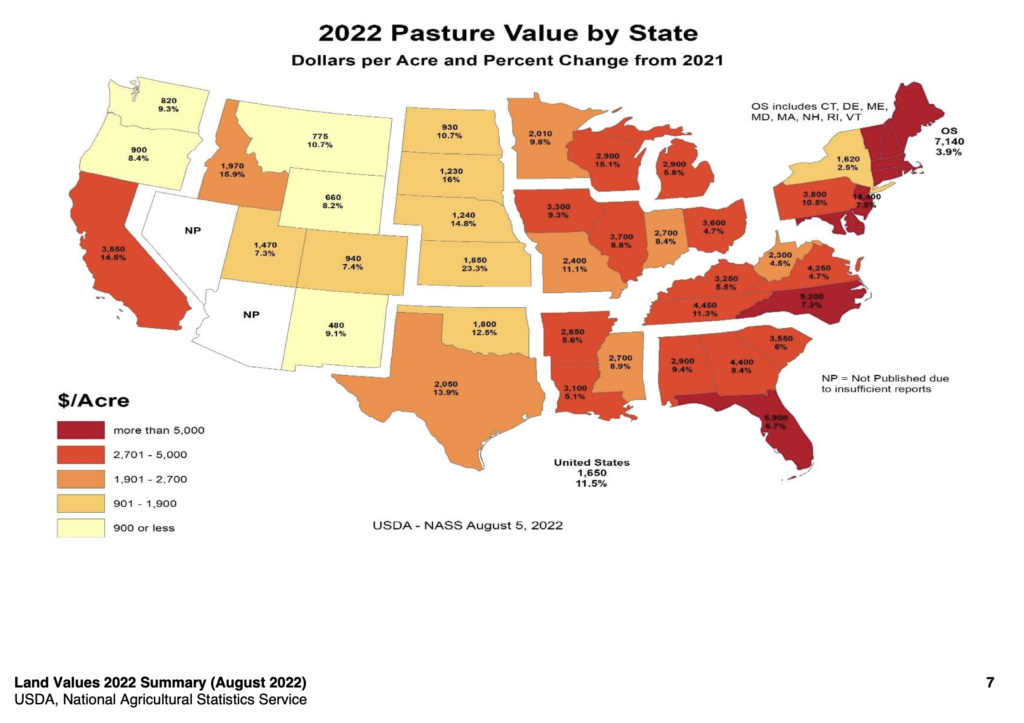The Federal Reserve Bank of Minneapolis reports that the price of farmland in South Dakota is up 11.5% from last year—and that’s adjusted for inflation. Minnesota’s cropland values rose 10.4% beyond inflation. Nationally, cropland values rose 7.2% after inflation.
Adjusted for inflation, cropland values declined nationally and in Minnesota from 2014 through 2020 before bouncing upward again in 2021 and 2022. South Dakota’s cropland value slump began in 2015, then rebounded over the last two years with the rest of the nation.

In 2021 dollars, South Dakota’s cropland values are still 8.0% below their 2015 peak. North Dakota and Montana cropland values also remain below their 2015 peaks, while Minnesota and Wisconsin have fully recovered from their declines.
While cropland prices have grown faster than inflation in the last couple years, cropland rents have not kept up with inflation. In 2021 dollars, it’s cheaper to rent farmland now, throughout the Ninth District and on average nationwide, than it was during the mid-decade cropland price peak:

The USDA estimates that the highest cropland values are on the coasts, in New Jersey and California, where an acre of cropland costs over $15,000. No other state has a five-figure average cropland cost.

New Jersey also leads the nation in pasture value at $14,400 per acre, followed by New England states at $7,140 per acre.

For the whole kit and kaboodle, land and buildings, a farmer can get 5.9 times as much farm for the money in South Dakota as in New Jersey. Production expenses also appear to be 5.9 times higher per acre in New jersey than in South Dakota, but if you divide total state farm income by total farm acreage for each state, you will find that New Jersey farmers produce 6.6 times more income per acre than South Dakota farmers do. New Jersey farmers might thus want to keep operating in their more expensive but more profitable market and save their money to buy a nice little hobby farm for retirement along the Big Sioux.
Wetlands are being destroyed for cropland, livestock demands on water supplies dwarf the needs of cities, global biodiversity is threatened, Arctic ice packs are disappearing, humans are breeding less nutritious food and pesticides are killing native pollinators.
Waters of the United States or WOTUS legislation seeks to give authority to EPA and the Corps to use some teeth to enforce the rights of people downstream to have clean water. But Republicans and their toadies cry government overreach while WOTUS architects regroup for another round in Congress. Sackett v. EPA is in the Supreme Court spotlight in a test of the authority of the agency to regulate wetland protection.
So, fifteen Earth haters in the US House of Representatives want lawmakers to wait on new Clean Water legislation in anticipation that a Trump-packed Supreme Court of the United States will reverse environmental protection for a majority of American citizens and enable the corporatocracy to pollute at will.
Highest quality food in America comes from the two states where an acre runs $15k+. Both states have supported the Democratic candidate for President since 1992. The point is backwater rural states are overrepresented in Washington and Dems intend to put an equality of population measure into effect.
Read ’em and weep, Senators Thune and Rounds.
For a time, Lloyd West, Mike Trucano and Paul Miller owned Deadwood. The Thorpe’s strike took down West, cocaine and philandering took Paul down then Trucano retired a rich Republican donating to the Governors Club.
Paul attended grade school and Deadwood High with members of the Fierro family then hired Larry, John and Richard. Their father, Ysidro came from Mexico with his mother Beatrice Antuna and his step-father then married Jennie Grado in Deadwood in 1935 and had thirteen kids. When he died in 2018 he had 50 grandchildren, 103 great-grandchildren and 55 great-great-grandchildren.
Paul’s dad Dave, his uncles Paul and Bruce, father of Gary Mule Deer. built Twin City Fruit and told stories about beating checks back to Deadwood driving rickety old trucks on gravel roads from Deadwood to Denver’s Denargo Market peddling produce from Scottsbluff, Nebraska back to the Gulch. They owned the Scottsbluff market back-hauling beet sugar and Rockyford melons from eastern Colorado. Denver-based competitor Nobel also distributed there but it was absorbed by Houston-based Sysco, the division that ultimately bought TCF. Behind the warehouse on Miller Street hundred pound sacks of Colorado and Nebraska potatoes were unloaded from the rail spur that is now home to the Mickelson Trail. Paul’s uncle Bruce built the Miller Ranch on old US14 in Spearditch.
Today, the Ogallala Aquifer, also called the Great Plains Aquifer, is being depleted at a far faster rate than its recharge flows and nearly all the groundwater sampled from it is contaminated with uranium and nitrates from industrial agriculture.
Nebraska’s Republican cannaphobic governor is panicking and blaming Colorado where growing those Rockyford melons with Arkansas River water is really expensive.
In May this scribe did a 2000 mile loop to Vermillion, South Dakota and back again where the number of cattle feedlots in Kansas, Nebraska and eastern Colorado draining the Ogallala Aquifer is staggering. The Arkansas River was dry at Dodge City, Kansas and thousands of confined feeder cattle valued at some $2000 per head died in June.
My guess? Cropland parity will happen immediately after Stan Adelstein and Hani Shafai polish off that kosher spiral cut Smithfield ham.
South Dakota will always be fly over country because we barely have the rainfall to sustain agriculture, and therefor, marginally sustain life.
https://www.youtube.com/watch?v=wwJABxjcvUc
Yet, with 2 engineering schools SD should be doing much better. Deere plans putting the farm’s hired man out of business by 2030.
https://www.cnbc.com/2022/10/02/how-deere-plans-to-build-a-world-of-fully-autonomous-farming-by-2030.html
What else is driving the recent rise in farmland values–come rain or come shine?
As the EWG Environmental Working Group reports–millions and millions of dollars of taxpayer subsidized federal crop insurance payments.
South Dakota counties lead the nation in receiving crop insurance largesse. Farmland is a risk-free investment courtesy of growing federal farm
payments to landwoners.
https://www.ewg.org/research/new-ewg-map-highlights-mississippi-river-region-crop-insurance-payout-hot-spots
As Bill Gates says, “There is no downside risk to owning farmland,”–and he buys more.
https://www.aei.org/op-eds/bill-gates-and-warren-buffet-should-thank-american-taxpayers-for-their-profitable-farmland-investments/
https://www.youtube.com/watch?v=MJVL9HegCr4
50 plus acres of farmland near Remsen, iowa sold for a new state record 26,250 bucks per acre.
https://journalstar.com/agriculture/farmland-in-northwest-iowa-sells-for-record-26-250-per-acre/article_d54a675d-0fb1-5ddf-9bb4-62587d9e8043.html
Remsen sits on Hiway 3 between Lemars and Cherokee in Plymouith County.